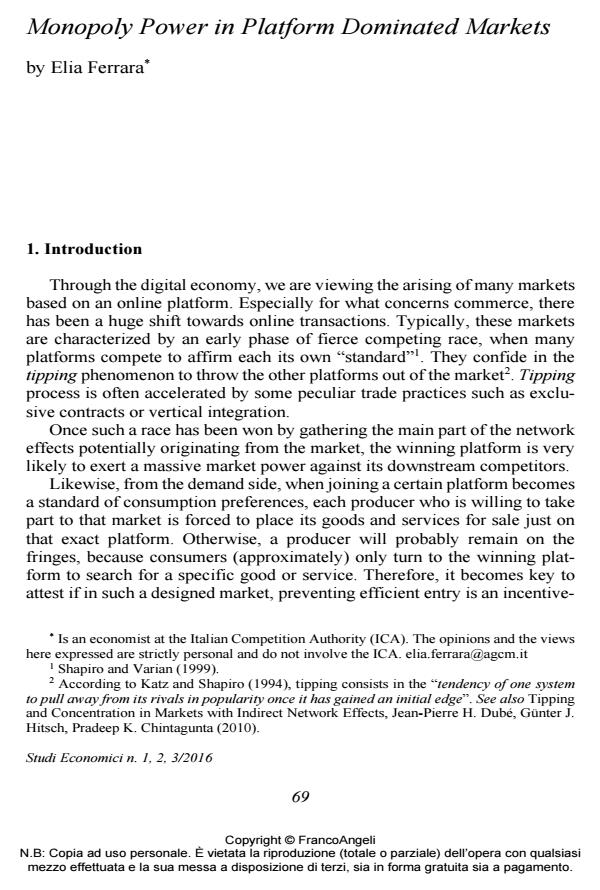Monopoly Power in Platform Dominated Markets
Titolo Rivista STUDI ECONOMICI
Autori/Curatori Elia Ferrara
Anno di pubblicazione 2017 Fascicolo 2016/118-119-120 Lingua Inglese
Numero pagine 19 P. 69-87 Dimensione file 260 KB
DOI 10.3280/STE2016-118005
Il DOI è il codice a barre della proprietà intellettuale: per saperne di più
clicca qui
Qui sotto puoi vedere in anteprima la prima pagina di questo articolo.
Se questo articolo ti interessa, lo puoi acquistare (e scaricare in formato pdf) seguendo le facili indicazioni per acquistare il download credit. Acquista Download Credits per scaricare questo Articolo in formato PDF

FrancoAngeli è membro della Publishers International Linking Association, Inc (PILA)associazione indipendente e non profit per facilitare (attraverso i servizi tecnologici implementati da CrossRef.org) l’accesso degli studiosi ai contenuti digitali nelle pubblicazioni professionali e scientifiche
This paper gives a representation of a platform-dominated market. We characterize a market where a vertically integrated sales platform compete downstream with a firm selling a smaller subset of goods. The platform owner and the down-stream firm compete through the price (quantity variable) and the delivery time (quality variable), We find that in equilibrium the demand for the competitor’s good is more elastic than the platform owner’s demand with respect to the delivery time and that competitor’s consumers are more sensitive to changes in the delivery times rather than in the price. Furthermore, we find that when the platform owner’s demand elasticity is sufficiently high, then it could partially discipline the market power the platform owner can exert against its downstream competitor. However, if the cross-price elasticity is significant as well, the platform owner is likely to un-dermine the strength of competition by raising the access price to its platform.
Keywords:Platform, competition, regulation, vertical restraints, access price, mar-ket power
Jel codes:D42, D43, L41, L43, L51
- Argentesi E., Filustrucchi L. (2005), “Estimating Market Power in a Two-Sided Market: the Case of Newspaper”, EUI Working Paper ECO No. 2005/7.
- Boik A., Corts A.S. (2016), “The Effects of Platform Most-Favoured-Nations Clauses on Competition and Entry”, Journal of Law and Economics, 59, 105-134.
- Church J., Gandal N. (2004), Platform Competition in Telecommunications. Prepared for The Handbook of Telecommunications, vol. 2 edited by Cave M., Majumdar S. and Vogelsang I, North-Holland, Amsterdam.
- Dubé J.H., Hitsch G.J., Chintagunta P.K. (2010), “Tipping and Concentration in Markets with Indirect Network Effects”, Marketing Science, 29, 2, 216-249.
- Economides N., Hermalin B.E. (2014), The Strategic Use of Download Limits by a Monopoly Platform, University Law and Economics Working Papers, New York.
- Eisenmann T.R., Parker G., Van Alstyne M. (2008), Opening Platforms: How, When and Why?. Working Paper. Harvard Business School.
- Evans D.S. (2003), “The Antitrust Economics of Multi-Sided Platform Markets”, Yale Journal on Regulation, 20, 2, 4.
- Evans D.S., Schmalensee R. (2007), “The Industrial Organization of Markets with Two-Sided Platforms”, Competition Policy International, 3, 151-179.
- Farrel J., Weiser P. (2003), “Modularity, Vertical Integration, and Open Access Policies: Towards a Convergence of Antitrust and Regulation in the Internet Age”, Harvard Journal of Law & Technology, 17, 1, 85-134.
- Gabszewicz J.J., Wauthy X.Y. (2005), “Two-Sided Markets and Price Competition with Multi-homing”, CORE Discussion Papers 2004030, Université catholique de Louvain, Center for Operations Research and Econometrics (CORE).
- Gawer A., Cusumano M.A. (2008), “How Companies Become Platform Leaders”, MIT Sloan Management Review, 49 (2), 28-35.
- Katz M.L., Shapiro C. (1994), “System Competition and Network Effects”, The Journal of Economic Perspectives, 8, 2, 93-115.
- Lee R.S. (2013), “Vertical Integration and Exclusivity in Platform and Two-Sided Markets”, The American Economics Review, 103, 7, 2960-3000.
- Nocke V., Peitz M., Stahl K. (2004), “Platform Owner”. Discussion Paper No. 16, Governance and the Efficiency of Economic System.
- O’Brien D.P., Wickelgren A.L. (2003), “A Critical Analysis of Critical Loss Analysis”. Working Paper from the Bureau of Economics of Federal Trade Com-mission of the USA.
- Schmalensee R. (2000), “Antitrust Issues in Schumpeterian Industries”, The American Economic Review, 90, 2, Papers and Proceedings of the One Hundred Twelfth Annual Meeting of the American Economic Association (May, 2000), 192-196.
- Shapiro C. (1996), “Mergers with Differentiated Products”, Antitrust Magazine, Spring, 23-30.
- Shapiro C., Varian H.R. (1999), Information Rules: A Strategic Guide to the Network Economy. Harvard Business Press, Boston, MA.
- Spulber D.F., Yoo C.S. (2005), “Network Regulation: the Many Faces of Access”, Journal of Competition Law and Economics, 1(4), 635-678.
- Zennyo Y. (2016), “Competition between Vertically Differentiated Platforms”, Journal of Industry, Competition and Trade, 3, 309-321.
Elia Ferrara, Monopoly Power in Platform Dominated Markets in "STUDI ECONOMICI " 118-119-120/2016, pp 69-87, DOI: 10.3280/STE2016-118005